The Triboro RX Line was proposed in the Third Regional Plan back in 1996. The idea is simple: there are many unused or under-used rail lines that cross through the outer boroughs which could be used to provide passenger rail service to undeserved areas of the city. What’s more, many of these lines link up, in a sort of rail network, so that with only marginal extra construction a new “loop” or “crosstown” subway/commuter rail line could be created. The line was called Triboro RX and began at the waterfront in Bay Ridge, Brooklyn. The Long Island Railroad Bay Ridge Line was once part of the rail system which brought city dwellers to Coney Island back in the late 19th and early 20th century. When many of these lines were converted to subways the Bay Ridge Line stopped carrying passengers and today only carries freight. The line makes a broad arc through southern Brooklyn from Bay Ridge to Broadway Junction, almost as if you drew it with a compass.
What makes this line so appealing is that it would connect to every subway in Brooklyn (except the Brooklyn-Queens Crosstown Line) and would act like a shuttle to bring passengers over to lines which might not connect even in downtown Brooklyn or Manhattan. The line would also bring subway access to areas of Flatlands, East Flatbush, and Canarsie which today are woefully under served.

An interesting side note is that this is not the first time that mass transit has been proposed for this corridor. Back in the 1960s Robert Moses wanted to use this right-of-way for a highway, the Cross-Brooklyn Expressway. To get public support for the plan the proposal called for a below grade highway with mass transit along side (see drawing at left). Above, to cover the highway, would have been a linear park system with large apartment buildings, dubbed the Linear City. While it was an interesting idea, in reality such a project would have destroyed neighborhoods, increased traffic, and dotted the landscape with offensive and inhuman towers. The park probably would have been thrown out in early plans because of cost overruns and most likely so would have the mass transit line. Because this corridor is still so important, the idea of a Cross Brooklyn Expressway is still being mulled around by transportation planners, in some cases combined with a cross harbor freight tunnel.
After the Triboro RX whips around southern Brooklyn it comes up through Broadway Junction. At this point the line would, if built as a subway, run along the same tracks as the BMT Canarsie L Line. The Canarsie Line at this point is elevated but runs along side the Bay Ridge Line which is sunk below grade (click here to see a picture I took of this spot). Plans as far back as the 1960s called for demolishing the elevated structure and rebuilding it in the railroad trench. If the Triboro RX was built then this would be part of the plan, with the current elevated stations replaced with new below grade stations. The trench at this point could be built over with a park and/or housing, much like the original Linear City plan at a much smaller scale.
After Broadway Junction the Triboro RX would continue along the Canarsie Line until it (the Canarsie Line) turns towards Bushwick, at which point the Triboro RX would head through Ridgewood and into Middle Villege, Maspeth, and into Jackson Heights. In Jackson Heights there are two options for where the line could run; The original RPA plan just has the line continuing along the existing railroad line up into Astoria but there is a little know abandoned subway tunnel and station at the Roosevelt Ave station which could be used to more conveniently connect the Triboro RX to the Queens Blvd Line (E,F,M,R trains) and Flushing Line (7 train). The additional station was built by the IND when the Queens Blvd Line was first constructed in the 1930s. The original concept was for a subway to the Rockaways to use the station, one service would connect to the Queens Blvd Line while one service would terminate at Roosevelt Ave. (For more information check out the Roosevelt Ave page at Joseph Brennan fantastic Abandoned Stations site.)
The Triboro RX would continue along through Astoria where it would travel up to 7 stories in the air along the Hell Gate Bridge. Stations at this point would need to be engineered into the viaduct which would add to the cost but would allow for spectacular views of the city (and of course, transfers to other subway lines). On Randalls Island there could also be a station, though it would likely have the lowest ridership in the system. The island is home to concerts, ball fields, and a psychiatric center and is well served by buses but a station would do more to open the island up to people who’ve probably never thought about going there.
The last section of the line enters the south Bronx through Port Morris and has two possible routes; The first, as proposed by the RPA, would utilize an abandoned freight rail tunnel which used to serve the port and warehouses. The tunnel runs under St. Mary’s Park and links up with the MetroNorth Harlem River Line at Melrose Ave. Here the Triboro RX would turn back south and head west under 161st St to Yankee Stadium. The RPA plan calls for the line to terminate at 161st/Yankee Stadium but I propose that the line link up with the IND Grand Concourse B/D Line and head into Manhattan, terminating at 145th St. This would make for fewer transfers and allow Manhattan better access to the outer boroughs (so, if a subway tunnel to Staten Island was to be constructed, this line would be the only subway route to travel through ever borough).
An alternative route would take the Triboro RX closer to Hunts Point before turning west under 163rd St. In my Second Ave Subway proposal I call for a 4 track subway under 163rd St to serve two Second Ave trains to Throgs Neck and Co-op City. If this tunnel was to be built then the Triboro RX line could share the trackage. After 3rd Ave it would continue to Yankee Stadium, thus creating a crosstown subway of sorts through the south Bronx.
The Atlantic Ave Super-Express comes from a 1999 RPA proposal. The MetroLink was the RPAs concept of an integrated Second Ave Subway system which would save on construction costs by utilizing existing infrastructure, much of which I covered in my Second Ave Subway proposals. A major element to the RPA proposal was the conversion of the Long Island Railroad Atlantic Branch which runs under Atlantic Ave from Jamaica to Flatbush Ave. The RPA proposed continuing the Second Ave Subway from lower Manhattan to Atlantic Ave where the subway would run express out to Jamaica with two branches, one to Jamaica Center and another to JFK Airport. Interestingly, the RPA also proposed that these two branches terminate, in Manhattan, at Grand Central Terminal via a short spur under 42nd St.
The most important, and most expensive, part of a Super-Express subway along Atlantic Ave would be the connection to Manhattan from Brooklyn. Over the last 10 years planners and politicians have tried to find a way to connect lower Manhattan with either the Long Island Railroad or just to JFK via a subway or extension of the AirTrain. The problem has been cost; any plausible plan would be in the billions. The most recent plans floated called for extending the LIRR into Manhattan via a tunnel with a new terminal in lower Manhattan. Because of the space required such a terminal would be prohibitively expensive. If, however, the LIRR along Atlantic Ave was to be converted to subway service then it could be cheaply connected to existing service via the Manhattan Bridge (into Chambers St) or via the Nassau St subway. Alternatively, if the Second Ave Subway was finished through Water St then this tunnel could then connect to Atlantic Ave (proposed for the MetroLink).
An even more radical idea would be to extend it over the Brooklyn Bridge where it would run from Chamber St, over the bridge and under Adams St to Atlantic Ave. Such a plan is not without precedent; trains ran over the bridge when it first opened and when the BMT was building their subways through lower Manhattan there was a very serious plan to build this exact connection. There was originally to be two large loops, one which ran from DeKalb St in Brooklyn, over the Manhattan Bridge to Chambers St and down through Nassau St, under the East River via the tunnel, and linking back up with DeKalb St back in Brooklyn. This loop was built.
The second one, a much larger loop was not. This loop would have started out at Broadway Junction in East New York. Using the Broadway Elevated Line (J/M/Z trains), it would enter Manhattan via the Williamsburg Bridge where it would run to Chambers St via the Centre St Subway. After Chambers St it would make a sharp turn and head to Brooklyn via the Brooklyn Bridge. From here trains would make their way back to Broadway Junction via any number of the elevated lines which snaked through Bedford-Stuyvesant at the time (Myrtle Ave, Lexington Ave, or Fulton St Els). Today, however, it may seem impractical to have trains running on the Brooklyn Bridge, but in a future where gas is much more expensive it would make sense given how many more people trains can carry. (For more information and better diagrams showing this proposed connection check out the Chambers St page at Joseph Brennan fantastic Abandoned Stations site.)
On the Brooklyn side, the LIRR terminates at Flatbush Ave so a new tunnel would need to be cut from Flatbush to the East River. This would be the most expensive part (along with a new tunnel if such a plan was chosen) but one which is also not without precedent. When the LIRR was originally built it in fact ran all the way to ferries on the East River. A large ditch was cut through Brooklyn Heights but the soot and noise so disturbed the populous that the railroad was ordered to cap the trench, thus making it a tunnel (and some would argue the first subway in the world). But tunnel system was so primitive that riding through the tunnel with the soot and noise was unbearable for riders. Soon the tunnel was shut down and service cut back to an above ground terminal at Flatbush Ave. The tunnel fell into legend until it was rediscovered by Bob Diamond in 1980. Today you can even take tours of the tunnel (for more information check out the BHRA’s web site.) Of course if a subway was to be built today it would not be able to reuse such a tunnel.
After Flatbush Ave the Super-Express Line would run down Atlantic Ave, making the existing stop at Nostrand Ave, to Broadway Junction. Here there are two options, the first is that the line could continue along Atlantic Ave out to Jamaica with no extra stops along the way, or it could link up with my previously proposed Bushwick Trunk Line. The Bushwick Trunk Line would allow trains to loop back through Chambers St like the original BMT plan, this time is extra express tracks through both Bushwick and along Atlantic Ave. On the Atlantic Ave side there would be only two tracks along Atlantic Ave from downtown Brooklyn to Broadway Junction. At Broadway Junction the Bushwick Trunk Line would connect with the Super-Express to create a 4 track subway from Broadway Junction, along Atlantic Ave in East New York, out to Jamaica. There could be three or four different train services: an all local train from Jamaica to Chambers St via Bushwick, an express train from Jamaica to Chamber St via Bushwick, an express train from Jamaica to Chambers St via Atlantic Ave, and an express loop which would run through Bushwick to Chambers St and back along Atlantic Ave.
From Broadway Junction to Jamaica it may make sense to rebuild Atlantic Ave with 4 tracks and demolish the existing elevated structure which runs through Cypress Hills and Richmond Hill. The elevated line was supposedly built to allow for an express track but one was never added. Because of this, and due to the fact that this section of trackage is the oldest in the entire New York City Subway system, it may be a good investment to replace the elevated structure with a 4 track subway along Atlantic Ave. Though passengers would no longer have a subway so close to them, a relocation would get rid of the blight which the line brings and allow for a much quicker commute into the city. And while some people would have to walk further, moving the line south would bring subway service closer to others.
In Jamaica Center the Super-Express Line would use the Archer Ave Subway. The original plan for the Archer Ave Subway (which would have served another super-express subway through Queens) was to have two branches, one running east along the LIRR right-of-way to Queens Village, and one running southeast along the Far Rockaway branch through Laurelton and Rosedale (which would replace LIRR service with subway service). These two extensions should still be a high expansion priority regardless if the Super-Express Line is built. Due to the congestion along the LIRR it might not be feasible to use the LIRR right-of-way to Queens Village so a two track subway might be built along Hollis Ave. This would more evenly distribute subway service but would be much more expensive. Another possibility is that if the IND Fulton St Subway extension was to be built then the two subways (that and the Super-Express) could link up allowing Queens Blvd trains to reach further into southeastern Queens.
Conclusion
I left these two expansion ideas for last because, while they score points in terms of cost, they seem like scraps compared to major projects like the Second Ave Subway. A giant loop subway connecting all boroughs seems good on paper but in reality it might not have the ridership to justify the cost. A crosstown subway from Brooklyn to Queens was planned for decades before it was finally built as the G train and today the G is perhaps the most loathed line in the system; it runs very infrequently and runs only 6 or 4 car trains as opposed to the usual 10 cars. It basically acts as a glorified shuttle. If the G, which actually runs between large employment centers and through dense residential neighborhoods, can hardly work out, how is a massive system like the Triboro RX to work? But at the same time the Triboro RX would run through major areas of the city which are far from other subways and would connect to almost every other line in the system.
The Atlantic Ave Super-Express also looks good on paper but once again the benefit might not out weigh the cost. The city has been trying for the last decade to bring the LIRR into lower Manhattan (or some variation) but the cost has just been too great. Still, the existing Broadway El can only serve Brooklyn for so long before it becomes obsolete. Converting Atlantic Ave into a subway which would serve new areas of the city and connect to the existing system to save on cost may, sooner rather than later, become a high priority project.
The futureNYCSubway
- IND Second System
- Post War Expansion
- The Second Ave Subway: History
- The Second Ave Subway: To The Bronx and the Nassau Line
- Brooklyn: Bushwick Trunk Line
- Manhattan: West Side and Hudson Crossings
- Queens: Flushing Trunk Line
- Staten Island: The Last Frontier
- TriboroRX and Atlantic Ave Super-Express
- Conclusion: the vanshnookenraggen plan

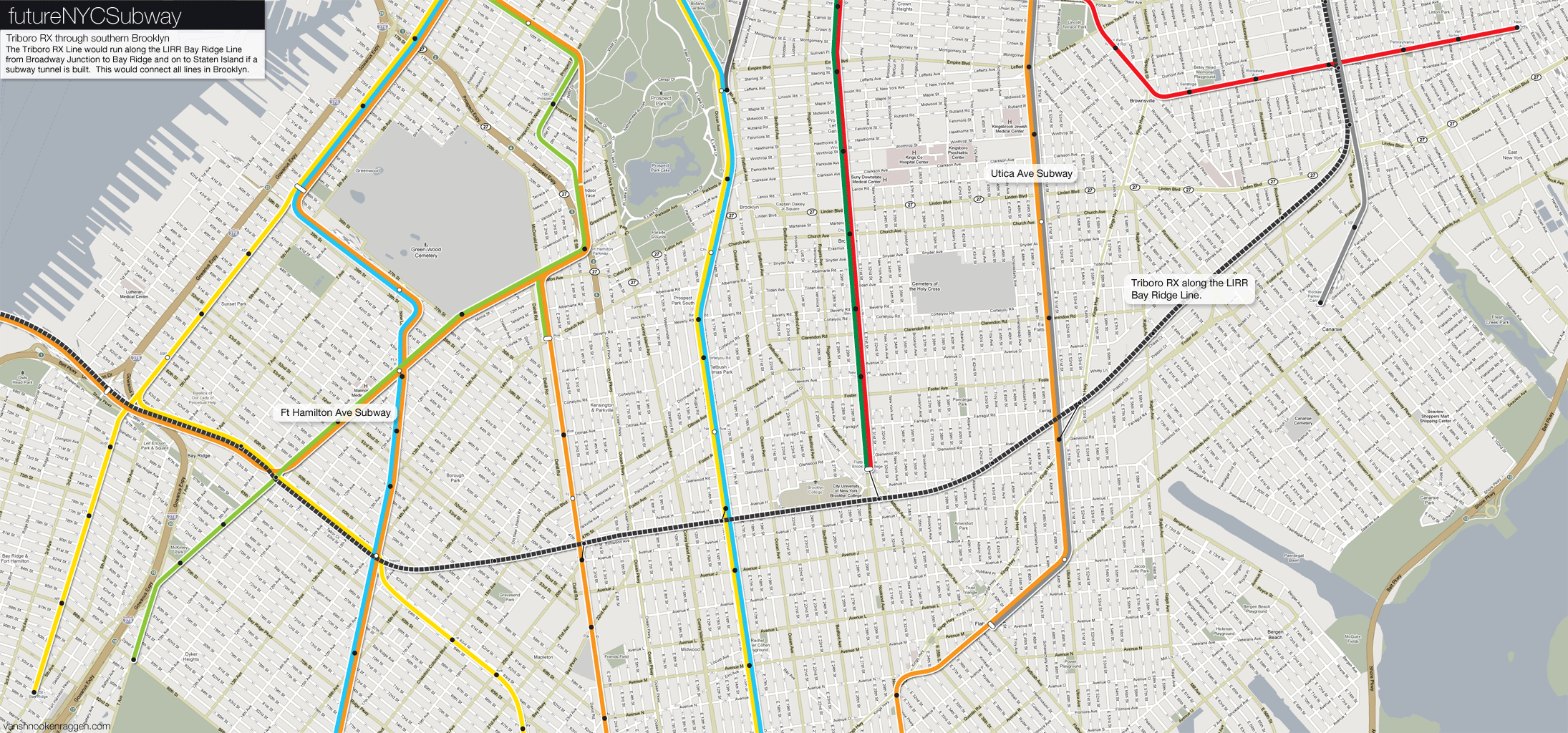
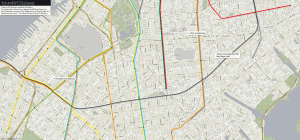
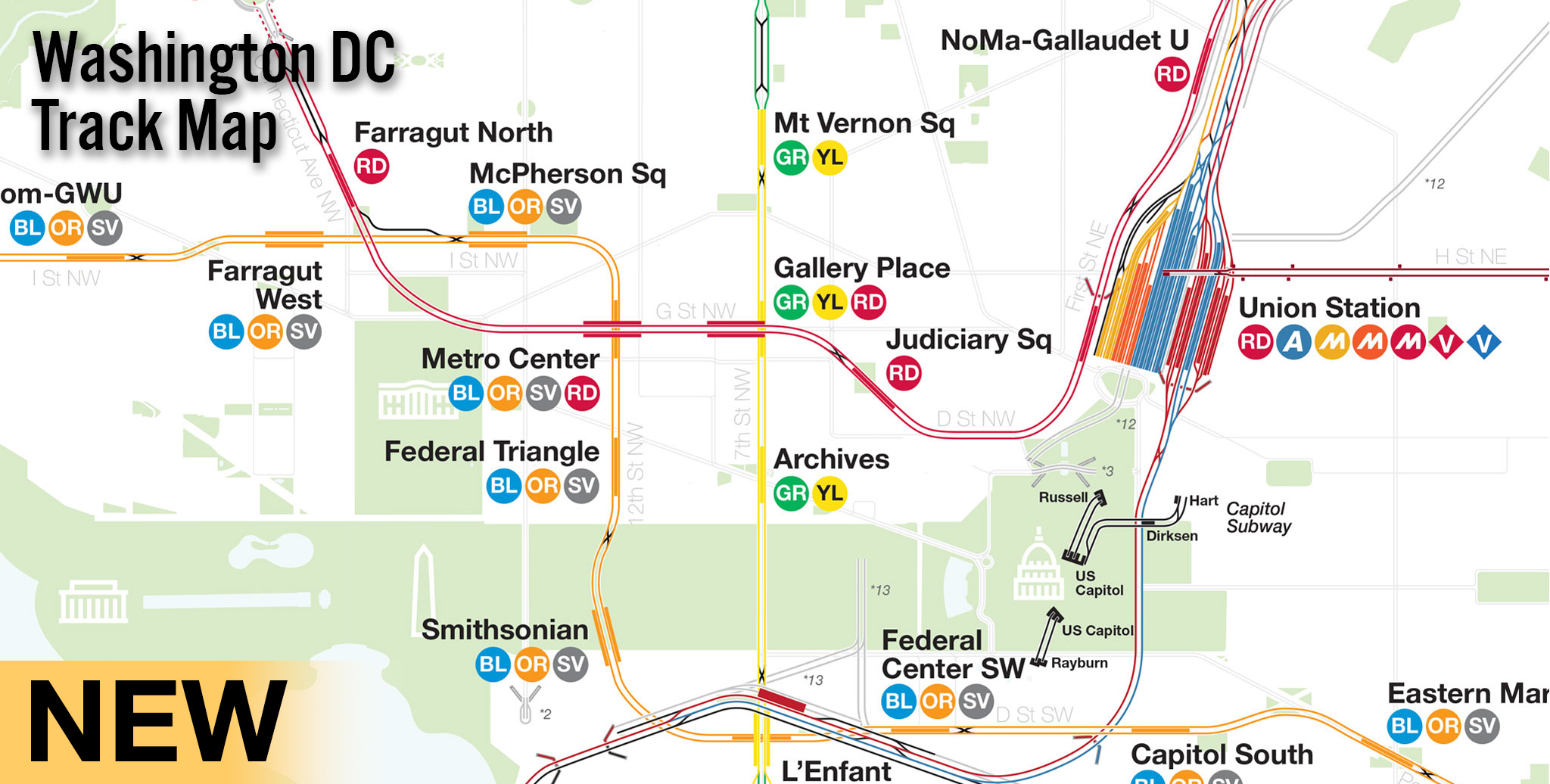
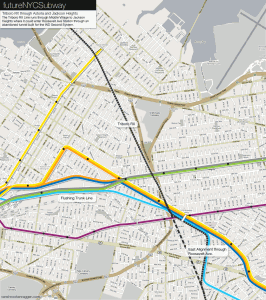
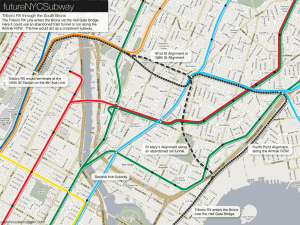
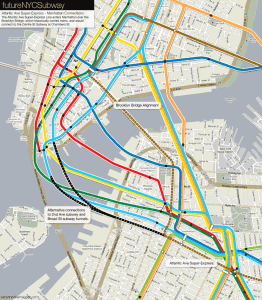
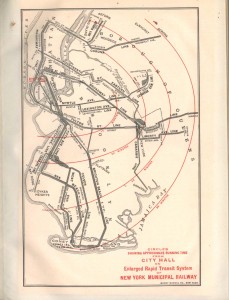
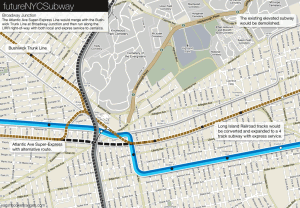
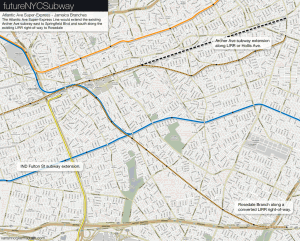
Really looking forward for the final map, to see how the new systems would intertwine… Talking about the metro link I was surprised that you did not include service between JFK and LGA in a form of probably a second (or third if you include the triboroRX) crosstown line to simplify the connection between the hubs. Don’t forget that the original air-train plans were service to extend from Jamaica to LGA via Flusing Meaddows, then through the RX to Sunnyside yard and then over the 59st Bridge (via the really narrow lane and the ped path) to the UES.
Also with cooperation of the PA I believe that the new Path’s WTC terminal should have a couple of extra tracks to be utilized as a terminal (or a stop if connection would be established to the GCT) from the metro link connection via the Atlantic LIRR line. Having in mind that both are PA operated there could be a one seat connection from JFK to Manhattan’s financial district, and when Path will be expanded to EWR connection between the regions 3 major airports will be easier than ever…
Keep up the extraordinary work…!
Keep up the really great work!!!
this is a great series! really lookin’ forward to the final chapter. Could you include a map similar to your ‘excerpt’ maps of the whole system? I think those look better than the other ‘final’ maps you’ve been releasing.
The reason the G is underused is bec it doesnt connect to Atlantic ave subway and the j train on broadway
The MTA should demolish the Hewes St and Lorimoer St stations on the JMZ and build a new one between them at Union St. Not only would it allow for transfers it would also speed up travel on the JMZ. The MTA has been on a kick recently of rebuilding stations to allow for better transfers (Columbus Circle, Court Sq, Jay St-MetroTech, Fulton St) and this should have been one of them.
Connecting the G to Atlantic Ave is going to be harder. The best bet would to built a mezzanine between the Fulton St stop and Atlantic Terminal using some sort of people mover (like at Court Sq). The problem with that is the distance; it is too far for a simple transfer. There isn’t really a good answer.
since you have five trains on the 8 Avenue line between 59th Street and 135th Street, you can extend the X towards the World Trade Center since none of the 8 Avenue trains use it.
I wouldn’t try converting the LIRR Atlantic Avenue Branch to a subway as we still need the LIRR branches. Parts of building the Triboro Rx would be difficult to build since parts of the line can only maintain two tracks and the portion of the tracks is used by amtrak.
I’d say go for the combine alternative tunnels which come off the two tail tracks from the nassau street subway and another from the second avenue subway towards the atlantic avenue terminal where the line can continue as two tracks towards two lines, one to the archer avenue subway at sutphin blvd and another along the fulton street extension at 111 street via atlantic avenue and rockaway boulevard without too much of an disturbance involving the construction next to the LIRR
another thing, instead of having the Z train back to Jamaica Center using the Atlantic Avenue Express, you can switch between the Z and the U train so the Z can travel to the 4th Avenue as the U can use the Atlantic Express.
Here’s another thing. A spur can be built from the d train that will pass under avenue u and go to kings plaza and possibly even mill basin.
The G is under-used for the following reasons:
1. Service has become progressively worse. Stations are falling apart, the number of cars per train have reduced, other service has cut back, and headways are longer.
2. The G doesn’t connect to as many lines. It connects to the A, C, D, E, F (twice), N, R, and 7. That is only 8 connections to other lines, and that number will go down to 6 if they follow through on the cutback to Smith-9th Streets.
This is how the RX will not have these problems:
1. Stations will be built as new, so it will come across as anything but neglected.
2. The RX connects to the A, B (twice), C, D (twice), E, F (twice), J, L (6 stations, I think), M (twice), N (twice), Q (twice), R (twice), Z, 2, 4, 5, 6, and 7 at various points. That would be 30 opportunities to transfer to a different subway line.
If the RX goes to Staten Island and/or Manhattan, that would take the line to another level. The cost won’t be nearly as great as other lines, because the tracks are in place.
Hello! About the Atlantic Avenue – Super Express I have made in my plans a new (Y) to run from the West End – Chambers Street to Eastern Queens near the Jamaica LIRR station. Also instead of having the line run on Atlantic Avenue I had the line run via Bergen Street and Liberty Avenue to not disrupt service on LIRR. Your ideas are great as I have thought of ideas based upon yours and I even used some of my own such as the (7) to Fulton Center via 11th Avenue and Greenwich Street. Also to establish the (3) to the Bronx via University Avenue to 195th Street. It is a 22 page document showing affects and ideas that are all based around expansion of the Second Avenue Subway. I am 12 years old and my name is Thomas Petluck
For the Triboro Rx would it be possible to use some of the Metro Norths M8 railcars? I just thought this because of the fact that since Metro North is going to Penn Station soon enough and since there’s also CSX on these corridors I thought having Metro North railcars for the Triboro Rx would be a better idea than converting the entire corridor into Subway. Also because of the projected 76,000 commuters for this line the trains can be 3 to 4 cars and can actually seat as much as a 8 to 10 car NYC Subway. If anything the TriBoro Rx can run the Metro North patterned schedule.
I’ve given the Triboro RX a lot more thought since writing this and I think you are going in the right direction. Further reading of the RPA plan doesn’t specify subway type trains but looks at a broader regional commuter rail network with the TriboroRX as a main component. I worked this into my latests FNYCS map but I’m still skeptical as to ridership numbers.
If it was just a matter of reactivating old rail lines then the costs would be reasonable. To really make this work would mean building new and often expensive connections between existing rail lines in often confined urban spaces. This is where I see the idea falling apart as costs balloon.
I think that if the city were to ever get serious about a cross-harbor tunnel then they could extend the TriboroRX to Staten Island and that MIGHT attract enough ridership to get the initial line running. But look at all the issues surrounding the Gateway/ARC tunnels which would carry many times the daily traffic that a cross-harbor tunnel would ever handle. I just don’t ever see this adding up.
Alright but seeing how Co Op City in your project is the terminus of the TriBoro Rx wouldn’t this serve enough commuters for this project. Obviously most of them are going to Manhattan but because of the major transfer spots this line can serve wouldn’t it be convenient to have a line like this which is less crowded and can get between the Bronx and Queens which you mentioned in one of your posts, and still get to Midtown before a 6 train which is the closest line to Co – Op City gets to 125th Street? I personally find that the TriBoro Rx is a project that can happen with the right planning and as I said before on one of my comments having M8 Railcars for the TriBoro Rx you agreed as a step in the right direction. Because of the fact that this plan is supposed to be more of an Inter – City line than a Subway in everyones minds these days the only real obstacle would be building stations or how you said having a Cross – Harbor Tunnel to Staten Island